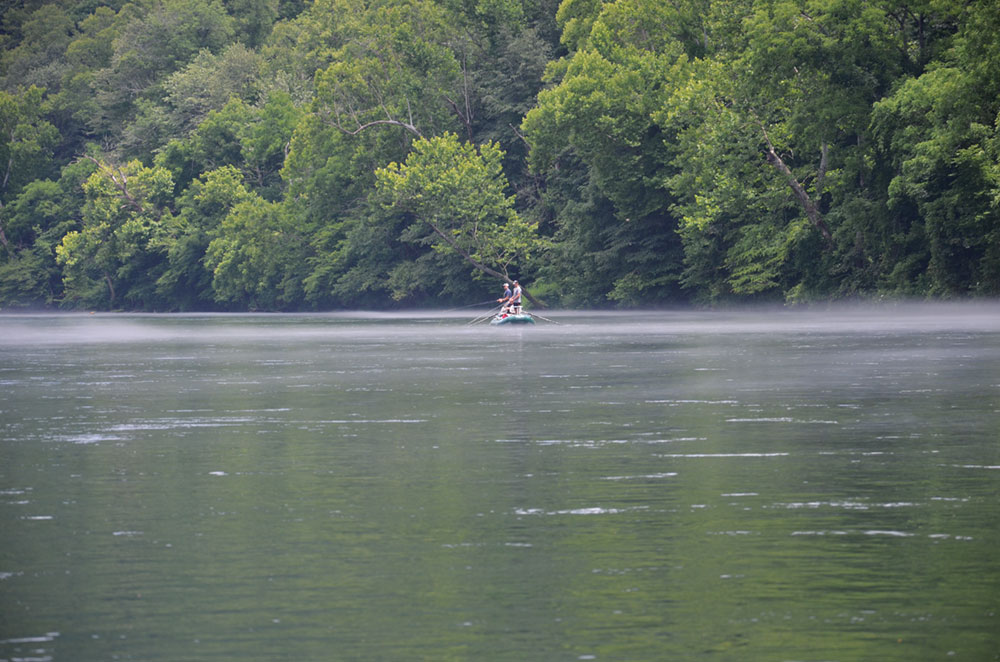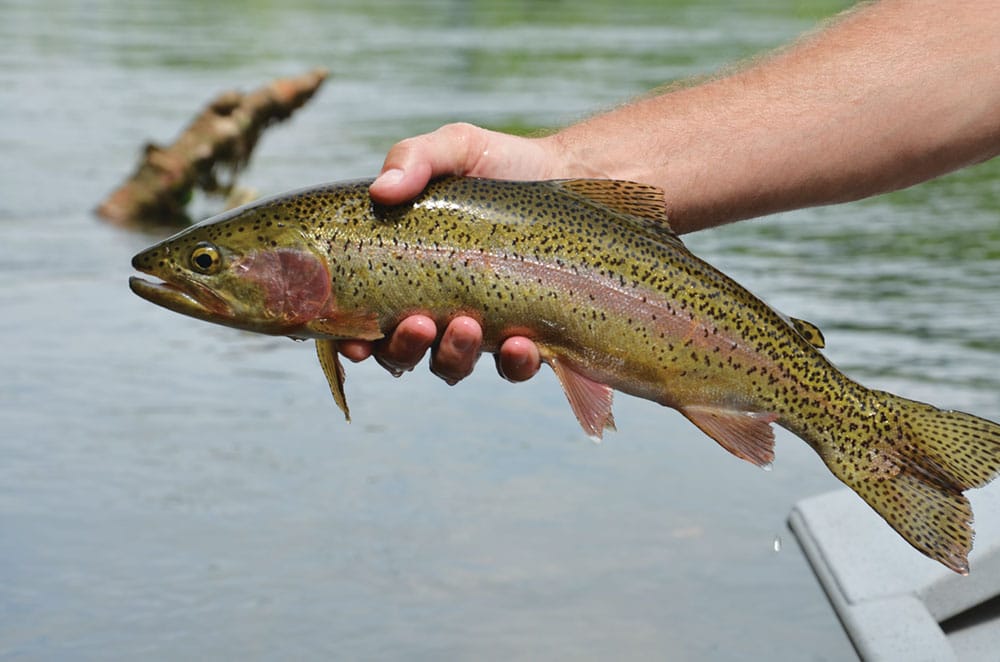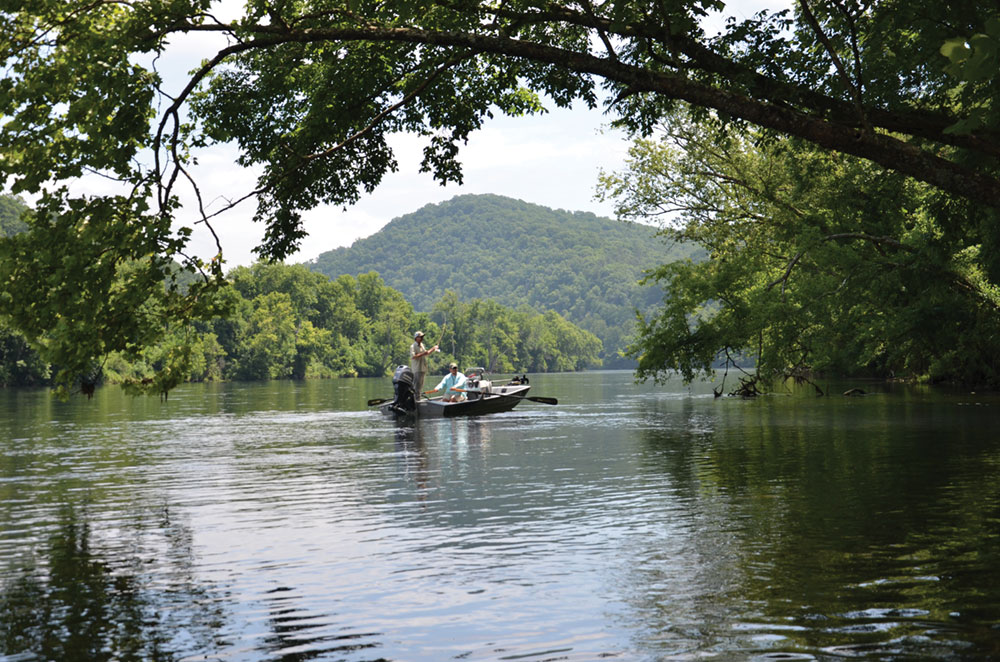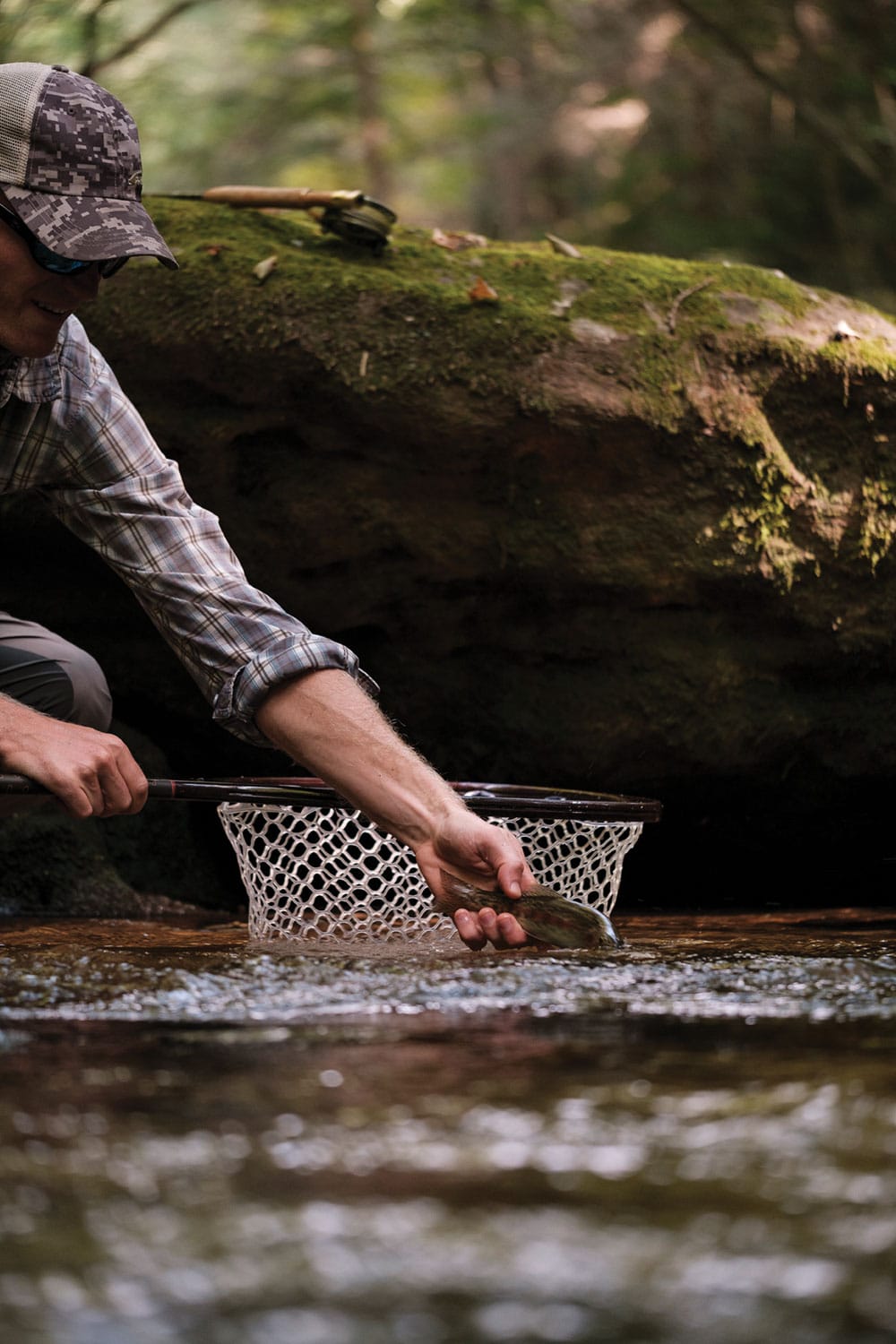Fishing Experts Reveal the Region’s Top Springtime Bites
It’s been a relatively mild, extra wet winter. Ask most fishing guides, and they’ll tell you these conditions make for excellent spring fishing. With that in mind, BRO went to the professionals to get the lowdown on the best places to get your rod bent this season.
Great Smoky Mountains, Tenn. & N.C.
From hike-in brookie streams to roadside rivers, there’s so much trout water in the Smokies it can be difficult to decide where to fish. The best bet for early spring is to stick with larger waters at lower elevations, said Ian Rutter, of R&R Fly Fishing. Rutter has guided the Smokies for more than a quarter century, and he’s learned to make fishing decisions “one day at a time” in spring’s unpredictable weather.
“In March and into April, we might still have some snow on the ground in those high elevations. It might still be a little slow up there,” he said. “At the same time, we’ll have hatches taking off in the afternoons at lower elevations, even on cold days.”
Excellent dry fly fishing is one of the great joys of spring in the Smokies. Rutter said it ramps up in March and April with Quill Gordons, early brown stoneflies, and some smaller dark mayflies, like blue-winged olives and blue quills.
“Oftentimes, you’ll have some combination of those bugs all at the same time,” said Rutter. “So the fish aren’t too particular. Even the ones that are particular aren’t as particular as some folks think they are.”
On the Tennessee side, Little River is one of the larger streams in the park. It offers roadside access along Little River Gorge Road east of Townsend and hike-in access upstream of Elkmont Campground.
On the North Carolina side of the national park, Rutter mentioned Deep Creek and the Oconaluftee River. Deep Creek is just north of Bryson City, N.C. Almost all of the best trout water is hike-in above Deep Creek Campground. The Oconaluftee parallels Hwy 441 north of Cherokee, and there is good roadside access. The “Luftee” is stocked within the Qualla Boundary of the Eastern Band of Cherokee Indians, but upstream of the reservation it is a wild trout fishery.
All three of these streams are large by Great Smoky Mountains standards. They all hold wild rainbow and brown trout. Rutter said anglers might be surprised by a big 16-inch brown trout on a dry fly in spring, but most fish will be the gorgeous 8- to 10-inchers the Smokies are known for.
Go Guided:
R&R Fly Fishing
www.RandRflyfishing.com
[email protected]

Staunton River, Virginia
In south-central Virginia, the Staunton River feeds Buggs Island Lake near the town of South Boston. Each spring, warming water temperatures ignite spawning runs, when reservoir fish push up into the river. Several species move up out of the lake, where they join resident river fish to create an exciting springtime fishery.
Starting in March and continuing into the summer, guide Matt Miles, of Matt Miles Fly Fishing, spends a lot of time on the lower end of the Staunton. Early in the season, he targets pre-spawn smallmouth bass, which are feeding up before going to the beds. Then, hordes of white bass push into the river. The white bass provide a fast-action precursor to the grand finale, when big river-run striped bass crash the party sometime in April and stay through the summer.
The lower seven miles of the Staunton above Buggs Island is a great stretch to sling streamers and baitfish patterns. “The smallies are focused on baitfish. They’re really trying to fill their guts before they go on the beds,” Miles says. “If you want to go out and catch a really heavy fish, that’s the time to do it.”
Spring smallmouth fishing is about quality rather than quantity. Miles said stripping steamers and covering lots of water might produce two fish or 10, but there’s a good chance for a four- or five-pounder.
Fast action occurs when big schools of white bass move in and stage up on structure. White bass aren’t huge fish, but they fight hard and they’re tasty.
Miles said he often drifts, casting Clouser Minnows around sandbars, downed trees, and creek mouths. When he catches one white bass, he’ll throw back to the same spot. It’s not unusual to catch 30 fish from the same piece of structure, and he’s had a few 75-fish days when white bass are thick.
Targeting smallmouth and white bass on the same float is fun, and anglers might also catch white perch, walleye, or an early striper. But all that shuts down when striped bass show up in numbers. These big, voracious predators send everything else into hiding. For Miles, that’s the time to break out heavier rods and bigger streamers.
The only drawback to this fishery is access. Miles said a jetboat is really the only way to fish it effectively.
Go Guided:
Matt Miles Fly Fishing
mattmilesflyfishing.com
[email protected]
434-238-2720

Toccoa River, Georgia
“Life is good right now; it should be even better this spring when they start putting fish in the river,” said Joe DiPietro in February.
DiPietro has guided on Georgia’s Toccoa River tailrace pretty much daily for as long as he can remember. He’s watched the cycles of the fishery over the years and said this spring should be a good one. “We’ve been catching a lot of nice brown trout, and that should continue into the spring,” he said.
“The trick is to get where they are, which is where the stockers aren’t.”
The Toccoa is a hatchery-supported tailrace that runs through the northeast Georgia mountain town of Blue Ridge. It supports a pretty spectacular mix of stocked trout, a few wild fish, and some holdover brown trout that grow quite large.
The Toccoa has a reputation for outsized browns, but it’s also a great dry fly fishery. Starting in March and running through April, mayflies take over as the late-winter caddis hatches ebb. DiPietro said Hendricksons, Cahills, and March browns will be the diet of rising fish.
Of course, there will also be freshly stocked trout in the river to run up your numbers fishing egg and worm patterns. But DiPietro said you’ve got to go natural to catch larger fish that have been in the river for a few seasons. Those big browns? They’ll pick off a nymph in the deep, slow runs. DiPietro suggested a double-nymph rig anchored by a big heavy stonefly this time of year. The stone gets your rig down to the bottom, where the fish are, and large sub-surface stoneflies are very much on the menu in early spring.
When the water is low, there are a few short stretches of accessible wading water. However, the best way to fish the Toccoa is to float. It is shallow and rocky, so choose a vessel with a shallow draft and expect to do some boat dragging.
Wading anglers and boaters should be wary of dam releases. The river can get dangerous quickly in rising water.
Go Guided:
North Georgia Trout Fishing
www.blueridgetroutfishing.com
[email protected]
706-851-400
Chattooga River, South Carolina
Karl Ekberg is especially bullish on one particular stretch of the Chattooga River.
In any section, the river is a special place. It forms the Georgia/South Carolina border, pretty much equidistant from the towns of Clayton, Ga., and Walhalla, S.C. There are more than 20 miles of trout water on the upper end of the river, and most of it is accessible only by foot from well-spread access points.
There are sections with mostly wild brown trout, as well as areas with heavy stockings. As co-owner of the Chattooga River Fly Shop, Ekberg suggested the piece of water through the gorge downstream of Burrells Ford Campground.
This gorge is relatively inaccessible, so South Carolina stocks it by dropping six- to 10-inch rainbow, brown, and brook trout from a giant bag slung beneath a helicopter. Stockings are conducted in fall, so by spring the fish are accustomed to a natural diet, and they have grown to eight or 12 inches under minimal fishing pressure.
“Hike down from Burrells Ford about 30 minutes toward Big Bend, and you’ll see a lot of hikers but very few anglers,” Ekberg said. “You’re almost guaranteed to catch a dozen fish in a half day down there.”
The fishery lights up in March and April. Ekberg likes to start mornings fishing a tandem nymph/soft-hackle rig, which he’ll switch to a dry fly with a soft hackle or a dry-dropper rig as fish start looking up midday. When the afternoon hatches start, you’ll likely see a mix of Quill Gordons, Hendricksons, big March browns, and tan caddis.
“We’re in wicked shape right now in terms of water conditions. It’s crazy how full the water table is, and everything I’ve seen is calling for a cool, wet spring,” Ekberg said. “There are lots of holdover fish, lots of wild fish, and plenty of bugs for them to eat.
Something that must be mentioned in any discussion of the Chattooga is the presence of large brown trout. Fish from 16 inches to well above 20 inches are without a doubt in the river. Ekberg said there’s a decent chance of picking off a big brown running a bug rig in spring, but that most giants are caught on streamers. The drawback is your fish count goes way down if you fish streamers when there are so many bugs going on.
Go Guided:
Chattooga River Fly Shop
www.chattoogariverflyshop.com
[email protected]
864-638-2806

Cumberland River, Kentucky
Bill Stranahan fishes all over the region as a guide with Southeastern Anglers. He said the Cumberland River below Wolf Creek Dam is the hidden gem of the East.
This large tailwater trout fishery near Jamestown, Ky., fishes very well in spring. The only issue is finding a day to fish it. Fishable conditions are completely dam-driven. When Cumberland Lake is full, the U.S. Army Corps of Engineers runs frequent dam releases, which make float-trips difficult.
“Everything is based on water flows up there,” Stranahan said. “When it’s full, they’ll usually run it hard during the week and then slack off on weekends to provide something for recreation. Right now, Cumberland Lake is slap full.”
At lower water levels, the river is one of the best tailwaters in the country. Nymph rigs under an indicator or Euro-nymphing can lead to tremendous numbers days in spring. Stranahan said 20-fish days are not uncommon, and that 30- to 40-fish days are possible. The size of the rainbow, brown, and brook trout is also impressive, which is partly due to creel restrictions that keep fish in the river and growing.
There is a one-fish daily limit on brown trout, with a minimum size of 20 inches. All rainbow trout between 15 and 20 inches must be released immediately, and only one rainbow longer than 20 inches may be kept as part of a five-fish limit. Brook trout have a one-fish limit, with a 15-inch minimum size.
With regulations like those, it’s easy to believe Stranahan when he says they regularly have days of four or five slot-limit fish, and sometimes a couple fish longer than 20 inches.
Mayflies are the deal in spring. Stranahan said you’ll usually float into scattered risers when spatterings of sulphurs and cahills come off. This variety of bugs features three or four different shades of yellow and cream in sizes 12 to 14. That’s important to remember in your nymph selection, also.
The best way to turn the biggest fish in the river is with streamers, but only when they’re chasing.
“You never know when the streamer game will get going,” Stranahan said. “Sometimes those fish are known to get a little froggy, and then it’s on.”
For this, Stranahan keeps a 7-weight loaded with 200-grain sinking line to fish big, articulated Kelly Galloup-style patterns, large Woolly Buggers, and baitfish patterns.
Wading access to the Cumberland is difficult. As Stranahan put it, “It’s a boater’s river.”
Go Guided:
Southeastern Anglers
www.southeasternanglers.com
[email protected]
770-655-9210
Nick Carter is author of “Flyfisher’s Guide to North Carolina & Georgia.” It is available on Amazon or by contacting the author at [email protected].
Cover photo by Sammy Chang








